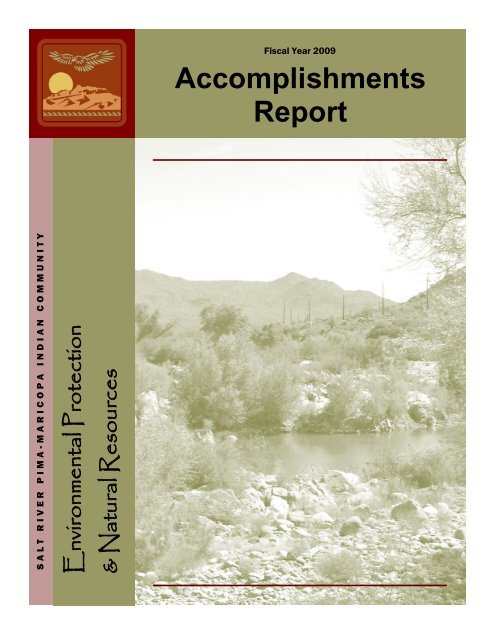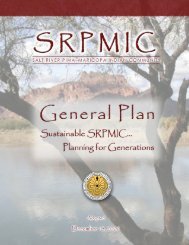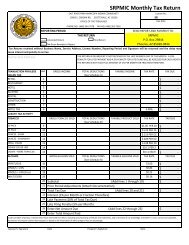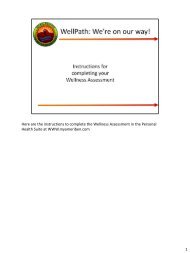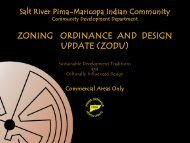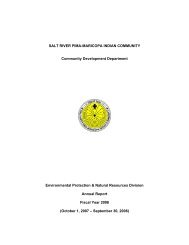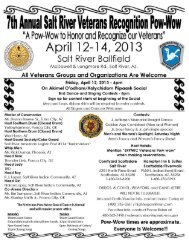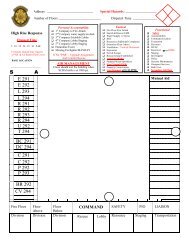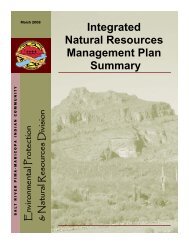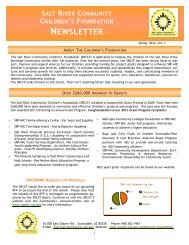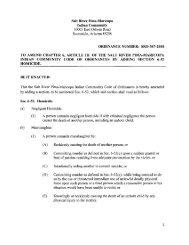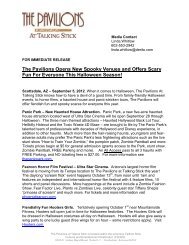2009 - Salt River Pima-Maricopa Indian Community
2009 - Salt River Pima-Maricopa Indian Community
2009 - Salt River Pima-Maricopa Indian Community
Create successful ePaper yourself
Turn your PDF publications into a flip-book with our unique Google optimized e-Paper software.
S A L T R I V E R P I M A - M A R I C O P A I N D I A N C O M M U N I T Y<br />
Environmental Protection<br />
& Natural Resources<br />
Fiscal Year <strong>2009</strong><br />
Accomplishments<br />
Report
Environmental Protection & Natural Resources<br />
Mission Statement<br />
The Environmental Protection & Natural Resources Department<br />
protects, preserves, restores, and regulates the <strong>Community</strong>’s natural<br />
resources and archaeological heritage by enforcing regulatory programs<br />
and providing educational opportunities to the <strong>Community</strong>.<br />
Cover Photo: The Verde <strong>River</strong> on the <strong>Salt</strong> <strong>River</strong> <strong>Pima</strong>-<strong>Maricopa</strong> <strong>Indian</strong> <strong>Community</strong>.
Table of Contents<br />
Introduction……………..…………………………….………………………….…...2<br />
Administration………………………………………………….………………..……3<br />
Air Quality…………….…………………………………………….………….....…..4<br />
Special Projects……………….………………………………………….…..…...…6<br />
Land Use Compliance……………………………………………………….…...…8<br />
Range Management…...……………….……………………...…...…..………….10<br />
Environmental Programs & Policy Development……………..…………………12<br />
Water Quality..…………………………………………………………………..….16<br />
Earth Day <strong>2009</strong>………….....………………..……...…………………...………...18<br />
Conclusion.…………………………………………...………………...…………..20<br />
1
Introduction<br />
EPNR <strong>2009</strong> Staff Photo (left to right)<br />
Back Row: Raleigh Lomatska, Dan Daggett, Mark Aaron, Wang Yu, Greg Little, Brian Gewecke<br />
Middle Row: Angela Cruz, Jenifer Williams, Joe “Cricket” Herrera, Stan Belone, Tom Wright, Chris Horan, Corwin Smith,<br />
Gina Leverette, Carol Hibbard, Amy Miguel, Denise Taylor, Elaina Osife<br />
Front Row: Esther Moyah and Ondrea Barber<br />
Not Pictured: Tudor Montague<br />
Environmental Protection & Natural Resources<br />
The mission of the Environmental Protection & Natural Resources Department (EPNR) is to<br />
protect, preserve, restore, and regulate the <strong>Community</strong>’s natural resources and archaeological<br />
heritage by enforcing regulatory programs and providing educational opportunities to the<br />
<strong>Community</strong>. EPNR administers environmental regulatory programs, addresses environmental<br />
issues, and monitors growth and development to reduce the impact to the <strong>Community</strong>’s<br />
environmental and natural resources. EPNR staff perform site inspections and monitoring<br />
activities to ensure compliance with <strong>Community</strong> and Federal laws. EPNR also manages and<br />
analyzes data, writes technical reports, and performs environmental outreach and education to<br />
increase awareness about environmental issues that impact the <strong>Community</strong>.<br />
EPNR consists of five distinct programs, with varied environmental and natural resource<br />
components. These include the Air Quality Program (AQP), Land Use Compliance Program<br />
(LUC), Range Management Program (RMP), Water Quality Program (WQP), and the<br />
Environmental Policy and Program Development (EPPD). Hazardous substances, pesticides<br />
issues, solid waste, recycling, and policy development are all housed under Environmental Policy<br />
and Program Development. The major accomplishments in Fiscal Year <strong>2009</strong> (FY<strong>2009</strong>) of these<br />
five programs are relayed in the following pages.<br />
2
Administration<br />
During <strong>2009</strong>, EPNR has experienced a reduction in resources that includes staff and funding. Between FY2008-<br />
<strong>2009</strong> EPNR lost 6 full time employees, more than 25% of it’s full time staff. However, EPNR is diligently seeking<br />
additional grant funds to augment the shortages while continually working towards improving and enhancing our<br />
programs. We are moving forward with developing environmental ordinances locally for the betterment of the<br />
<strong>Community</strong> and expanding our enforcement and compliance activities throughout the <strong>Community</strong>. EPNR<br />
continues to review and make improvements to processes to make them more efficient and finds creative ways to<br />
do more with less. One example of this is by replacing labor intensive monitoring equipment with automated<br />
continuous monitoring equipment. EPNR has also made use of available human resources by creating multiple<br />
volunteer opportunities, has supported many student internship programs and most recently has been involved in<br />
work with Workforce Investment Act (WIA) interns. EPNR has many outstanding accomplishments to highlight<br />
and recognize, however it is important to note that EPNR is still in the infancy stages of developing a<br />
comprehensive environmental protection program which includes monitoring, public outreach and education,<br />
enforcement & compliance responsibilities, restoration & remediation activities, and permitting functions.<br />
Additional financial and human resources are needed in order to fully develop programs that adequately provide<br />
the level of protection and oversight needed in order to ensure that the <strong>Community</strong>’s natural resources and<br />
archaeological heritage are preserved and protected.<br />
Environmental Protection<br />
&<br />
Natural Resources<br />
Organizational Chart<br />
3
Air Quality Program<br />
Summary<br />
The Air Quality Program’s (AQP) primary mission is to assess the SRPMIC air-shed as well as<br />
develop and implement an innovative regulatory program to address air quality issues. The AQP<br />
continues to develop a regulatory component whereby the <strong>Community</strong> can establish its<br />
jurisdictional authority for air pollution sources within its exterior reservation boundaries. The<br />
AQP focuses on protecting <strong>Community</strong> health and welfare by maintaining and enhancing air<br />
quality.<br />
Air Quality Website<br />
EPNR has augmented its outreach by providing air quality information on the internet for<br />
<strong>Community</strong> Members and others which includes an interactive air monitoring map, live web<br />
cameras showing current air quality (visibility) around Red Mountain and Camelback Mountains,<br />
as well as Air Quality Advisory Alerts. The website address is:<br />
http://www.srpmic-nsn.gov/government/epnr/aqhome.asp.<br />
Example Air Quality Alert advising of moderate air quality.<br />
The AQP utilizes the internet to provide valuable air<br />
quality information that can impact <strong>Community</strong> health.<br />
The Air Quality Program presents real-time web-cam views (left) as well as<br />
weather and air quality conditions (right) on its website.<br />
4
Air Quality Flagpoles<br />
Air Quality Index (AQI) flagpoles are being installed throughout the<br />
<strong>Community</strong> to display the <strong>Community</strong>’s air quality for those <strong>Community</strong><br />
Members who may not have access to computers or the internet.<br />
AQI flagpoles enable EPNR to communicate the<br />
air quality status in a simple but effective manner.<br />
The flag poles are placed in areas that contain “sensitive” populations such<br />
as elderly and children. The AQI flagpoles are at the Senior Center, <strong>Salt</strong><br />
<strong>River</strong> High School/Middle School, <strong>Salt</strong> <strong>River</strong> <strong>Community</strong> Center, Lehi<br />
<strong>Community</strong> Center, and the Two-Waters Government Complex.<br />
One AQI flagpole advising of moderate air<br />
quality in yellow.<br />
School Bus Idling<br />
EPNR worked with the <strong>Community</strong>’s Fleet Department to implement the<br />
<strong>Community</strong>’s School Bus Idling policy in order to protect student health at the<br />
local SRPMIC elementary, middle, and high schools. AQP staff used a ”train<br />
the trainer” model to train the Fleet manager on the School Bus Idling Policy<br />
who in turn trained all the school bus drivers on the policy. In addition AQP<br />
worked to modify the bus routes in the <strong>Community</strong> to avoid unpaved roads<br />
and reduce the exposure to particulate matter and air toxics for the<br />
<strong>Community</strong>’s children.<br />
Children’s health is paramount this policy<br />
decreases children’s exposure to diesel<br />
particulate matter.<br />
This policy is aimed at reducing exhaust<br />
fumes during bus idling.<br />
Regulatory Development<br />
It has been another exciting year for the AQP regulatory development. In an effort to undertake air quality<br />
programs under the Clean Air Act Amendments of 1990, the program initiated the Eligibility Determination by EPA<br />
Region IX. The Eligibility Determination Application or Treatment as a State was finalized, approved by the<br />
Council, and formally submitted to the EPA Region IX during FY 2008.<br />
EPA approved the Eligibility Determination<br />
under the Clean Air Act in FY<strong>2009</strong>.<br />
As part of the regulatory development process the AQP created a <strong>Community</strong> Air Quality Focus Group as a<br />
sounding board for the proposed Air Quality Fugitive Dust, Agricultural Fugitive Dust, Open Burning and any future<br />
air quality ordinances. AQP meets as needed with the group to discuss any proposed ordinances before<br />
presenting the information to <strong>Community</strong> Council for approval. The Air Quality Focus Group’s main task is to<br />
review all draft materials developed for the ordinances and make recommendations. The group consists of<br />
<strong>Community</strong> elders and land owners as well as representatives from <strong>Community</strong> owned businesses, governmental<br />
departments, cultural resources, youth council, and<br />
student council.<br />
5
Special Projects<br />
Fish Tissue Study<br />
In response to <strong>Community</strong> Member<br />
concerns, the Water Quality Program<br />
(WQP) staff in collaboration with staff<br />
from the SRPMIC’s Cultural<br />
Resources Department conducted a<br />
fish tissue study.<br />
Several species of fish were poleharvested<br />
from numerous locations<br />
along the <strong>Salt</strong> and Verde <strong>River</strong>s<br />
within the Communities boundary,<br />
processed, and sent to a laboratory<br />
for analysis.<br />
This study, which was fully funded<br />
by the <strong>Community</strong>, will allow the<br />
WQP to evaluate the accumulation of<br />
various toxins in fish tissue in order<br />
to continue protecting the health and<br />
welfare of <strong>Community</strong> Members.<br />
One fishing location along the <strong>Salt</strong> <strong>River</strong> selected for the study.<br />
This study illustrates the SRPMIC’s commitment<br />
to protecting the health of the people<br />
as well as its wildlife.<br />
A total of forty-two (42) individual fish comprised of six different game fish species were<br />
harvested from four fishing spots frequented by <strong>Community</strong> Members. Fish species included<br />
channel catfish, grass carp, striped bass, rainbow trout, blue gills, and green sun fish. The<br />
pollutants analyzed for in the fish tissue samples were arsenic, cadmium, methyl mercury,<br />
selenium, various organochlorine pesticides, polychlorinated biphenyls (PCBs), polynuclear<br />
aromatic hydrocarbons (PAHs), dioxins, and furans. After the final testing results are analyzed,<br />
a report will be completed and presented to the <strong>Community</strong>.<br />
Three specimens included in the fish tissue study.<br />
Each fish was measured and weighed prior to processing.<br />
6
National Environmental Information Exchange<br />
Network Project<br />
The National Environmental Information Exchange Network (NEIEN) Project is a significant initiative within EPNR<br />
that began in 2003 to streamline data collection, data submissions, and data management. During FY2008,<br />
EPNR developed web-based automated data quality checking and validation tools that enhanced the availability,<br />
integrity, quality, and utility of data exchanged. The technical computer facets were transferred to the<br />
<strong>Community</strong>’s Information Technology Department to initiate the Air Quality Subsystems (AQS), which officially<br />
launched in April <strong>2009</strong>.<br />
SRPMIC’s Air Quality Program is a pioneer in the Exchange Network;<br />
One of the first tribes to submit data via the network<br />
1 of only 5 tribal programs that submit air quality data through AQS<br />
1 of only 9 tribes to have an operational node<br />
1 of 4 tribes to enter data into the Facility Registry System<br />
The only tribe to submit data to Emission Inventory System<br />
SRPMIC’s Water Quality Program is on the verge of submitting their data through the Water Quality Exchange<br />
(WQX) which will be an important milestone achieved by only a handful of Tribal Governments nationwide. This<br />
project is funded through the EPA’s Information Exchange Network.<br />
The Air Quality Program’s website is directly connected to the NEIEN, allowing rapid exchange of real-time data.<br />
7
Land Use Compliance<br />
Summary<br />
Land Use Compliance (LUC) facilitates compliance for all home sites, rights-of-way, commercial<br />
development, and other ground-disturbing construction projects within the SRPMIC. LUC<br />
conducts environmental and cultural resource surveys prior to lease approval to ensure the<br />
protection of the <strong>Community</strong>’s cultural and natural resources.<br />
Extensive coordination with Engineering and Construction Services, Cultural Resources<br />
Department, Public Works, Membership and Real Property Management, the <strong>Community</strong><br />
Development Department, and others occurs to ensure that all projects are in compliance with<br />
environmental and archaeological laws and tribal ordinances.<br />
National Environmental Policy Act<br />
and Other Activities<br />
The National Environmental Policy Act (NEPA) applies to residential, commercial, and other<br />
projects within the <strong>Community</strong> that require the use of federal funding. NEPA allows for a<br />
complete environmental review and evaluation of projects initiated on <strong>Community</strong> lands. In<br />
<strong>2009</strong>, LUC completed reviews of 52 home sites for the <strong>Community</strong>.<br />
Other projects closely reviewed by LUC include proposals for the new Spring Training facility;<br />
improvements along McKellips Road, <strong>Pima</strong> Road, McDowell Road, and State Route 87; bridge<br />
construction across the <strong>Salt</strong> <strong>River</strong> at Gilbert Road and McKellips Road; and construction of an<br />
<strong>Indian</strong> Health Services Ambulatory Care Center at the corner of McDowell Road and State<br />
Route 87.<br />
This year, LUC also partnered with the <strong>Community</strong> Development Department and the Cultural<br />
Resources Department to develop a Cultural Sensitivity training, entitled “Can You Dig It”.<br />
These outreach programs provide introductions to the <strong>Community</strong>’s cultural, historical, and<br />
archaeological resources and emphasize the need for proper cultural and environmental<br />
reviews prior to any new ground-disturbing activities.<br />
The “Can You Dig It” training has informed over 1,200<br />
participants of the <strong>Community</strong>’s important and<br />
irreplaceable resources.<br />
Requests for Environmental Review<br />
The process for submitting a Request for Environmental Review (RER) was streamlined during<br />
<strong>2009</strong>. RERs are now available on EPNR’s SharePoint site, which can be filled out and<br />
submitted electronically. The RER goes directly into a database that is available to project<br />
managers in other departments, allowing them to track the status of EPNR’s review. Clearance<br />
memos are sent to the project managers when EPNR review has been completed. These<br />
clearance memos have also been streamlined to clarify any concerns that have been identified<br />
by EPNR, and to provide any stipulations that may be attached to the clearance.<br />
In <strong>2009</strong>, the Environmental Review process became<br />
electronic which greatly expedites communication<br />
between SRPMIC departments.<br />
8
Archaeology<br />
LUC’s Archaeology Program ensures compliance with the National Historic Preservation Act (NHPA) of 1966, and<br />
the <strong>Community</strong>’s Antiquities Ordinance (SRO-102-86) that provides additional protection of archaeological sites on<br />
the <strong>Salt</strong> <strong>River</strong> <strong>Pima</strong>-<strong>Maricopa</strong> <strong>Indian</strong> <strong>Community</strong>. Archaeological surveys and monitoring projects are routinely<br />
conducted for housing and infrastructure projects. Work performed by outside archaeological consultants is also<br />
closely reviewed to ensure compliance with federal laws as well as the tribal antiquities ordinance.<br />
This year, a major Huhugam archaeological site was stabilized and<br />
preserved for future generations of <strong>Community</strong> Members.<br />
Archaeological site before (left) and after (right) stabilization.<br />
Archaeological work completed in FY <strong>2009</strong> revealed important<br />
new information about the <strong>Community</strong>’s cultural resources.<br />
Recent archaeological testing identified a series of ancient<br />
canals that demonstrate the size and complexity of the<br />
Huhugam irrigation system near Oak Street and State Route 87.<br />
Monitoring also uncovered numerous Huhugam artifacts and<br />
features adjacent to the Two Waters complex and near the Red<br />
Mountain Trap and Skeet facility.<br />
The Staff Archaeologist assisted the Cultural Resource<br />
Department (CRD) in representing the <strong>Community</strong>’s interests<br />
outside of the reservation boundaries. LUC and CRD provided<br />
joint input into a new master plan for Papago Park and an<br />
interpretive plan for Mesa Grande. Both of these areas contain<br />
important sites occupied by the ancestors of the O’odham.<br />
Stone axes found near Two Waters.<br />
Enforcement and Compliance<br />
LUC is responsible for ensuring compliance with applicable federal and tribal environmental law and policy. Major<br />
inspection projects were conducted this year at CEMEX – Beeline Facility and all farming operations within the<br />
<strong>Community</strong>. Other Enforcement and Compliance activities included providing asbestos survey assistance; review<br />
and inspections for three proposed home demolitions; assisted and provided information for the removal of sulfuric<br />
acid from SRPMIC; and LUC also assisted in the clean up and the re-closure of a lagoon system.<br />
9
Range Management<br />
Hopi stallion with his band of mares.<br />
Summary<br />
The Range Management Program (RMP) was created as a result of a <strong>Community</strong> Ordinance<br />
set forth in 1995 which protects wild horses on the <strong>Community</strong> from sale and slaughter. It also<br />
requires RMP to reduce and prevent overpopulation, and to ensure the general health of the<br />
herds. Over the years, the RMP has expanded its effort to include other wildlife and assisting<br />
with drafting new <strong>Community</strong> ordinances that are important to the protection of the<br />
<strong>Community</strong>’s animals, plants, and open space and preserve areas.<br />
RMP assisted with drafting an SRPMIC Animal Welfare<br />
Ordinance to increase the protection of animals.<br />
Eagle Nestwatch Program<br />
RMP staff coordinated with Eagle<br />
Nestwatch personnel and Arizona<br />
Game and Fish staff assigned to the<br />
nesting area within the <strong>Community</strong>.<br />
SRPMIC Bald Eagle season required<br />
coordination between EPNR, <strong>Salt</strong> <strong>River</strong><br />
Rangers, Public Works staff, Bald Eagle<br />
Nest Watchers, Arizona Game and<br />
Fish, and Liberty Wildlife.<br />
Not only did EPNR Staff<br />
assist with identification<br />
banding of eagle chicks,<br />
but also facilitated the<br />
opportunity for<br />
<strong>Community</strong> elders to<br />
participate as well.<br />
Elder assisting with eagle chick banding.<br />
10
Wild Horse Donations and Adoptions<br />
As a means for reducing the <strong>Community</strong>’s wild horse population, the RMP has developed a successful Donation<br />
and Adoption Program. In <strong>2009</strong>, the Range Management Program coordinated with the Comanche Nation in<br />
Oklahoma on the donation of wild horses. The Donation Agreement was signed and pre-inspection has been<br />
completed.<br />
In the spring of 2010, seventy SRPMIC wild horses will<br />
be donated to the Comanche Nation in Oklahoma.<br />
Adopted horses in New Mexico.<br />
The RMP performs a final inspection after the animals have been adopted to ensure the animals have adequate<br />
living conditions. In <strong>2009</strong>, RMP staff completed final inspection for two SRPMIC wild horses that were adopted in<br />
2008 in New Mexico. Permanent Ownership papers were issued to the new owner. Similarly, the <strong>Community</strong>’s<br />
bison herd was moved to the Santee Sioux Tribe in Niobrara, Nebraska in FY 2008 and required the RMP to make<br />
a final inspection in FY <strong>2009</strong> for the SRPMIC bison donation to be completed.<br />
Donated bison herd in Nebraska.<br />
11
Environmental Programs &<br />
Policy Development<br />
Summary<br />
The Environmental Programs and Policy Development (EPPD) Program’s main goal is to prevent<br />
pollution within the <strong>Community</strong>. Activities carried out by this program are supported by the<br />
development of policies and ordinances designed to reduce the risks of exposure to<br />
contaminants and to safeguard human health and the environment. EPPD is comprised of the<br />
Solid Waste, Pesticide, Hazardous Substances, Recycling, and Environmental Policy Programs.<br />
Solid Waste<br />
The Solid Waste Program works toward reducing waste and pollution by responding to illegal<br />
dump sites in the <strong>Community</strong> and developing site cleanup plans. The Solid Waste Program often<br />
collaborates with Range Management and Engineering and Construction Services to address<br />
illegal dumpsites in the open range areas within the <strong>Community</strong> and facilitates enforcement<br />
actions against illegal dumpers with the <strong>Salt</strong> <strong>River</strong> Police Department.<br />
In FY<strong>2009</strong>, EPNR enhanced the Inoperable Vehicle Removal Program by teaming with Pavilions<br />
Auto Care to provide <strong>Community</strong> residents incentives for removing inoperable vehicles.<br />
The Solid Waste Program addresses illegal dump sites such as these abandoned tires (left) and<br />
abandoned vehicles (right), waste tire and inoperable vehicle removal are 2 services SRPMIC<br />
provides to the <strong>Community</strong> free of charge.<br />
2,621 waste tires and 6 inoperable vehicles<br />
were removed from the <strong>Community</strong> in FY<strong>2009</strong>.<br />
Pesticide Program<br />
The Pesticide Program oversees the safe use, transport, and storage of pesticides within the<br />
SRPMIC, both on agricultural lands and structural applications, to ensure compliance with federal<br />
and <strong>Community</strong> laws in order to protect agricultural worker safety, <strong>Community</strong> Members and<br />
residents, and the quality of the land, air, and water.<br />
Biennial pesticide safety training classes were hosted for employees of the leased farms<br />
operating within the <strong>Community</strong>, and for employees of Public Works and Water Resources. All<br />
attendees earned Pesticide Handler certifications valid for three years. EPNR coordinated with<br />
the Arizona Department of Agriculture and the Arizona Office of Pest Management to facilitate<br />
training and sampling activities with their staffs, and the review of licensing registrations and<br />
compliance documentation. EPNR created a notification form and a requisite database allowing<br />
for e-mail pre-notification of all pesticide applications within the <strong>Community</strong>.<br />
In FY<strong>2009</strong>, EPNR coordinated Worker Protection<br />
Standard inspection training activities with the Navajo<br />
Nation and the Colorado <strong>River</strong> <strong>Indian</strong> Tribes.<br />
12
Hazardous Substances Program<br />
The Hazardous Substances Program addresses accidental spills and illegal dumping acts in concert with the Solid<br />
Waste Program. Through this Program, commercial businesses are inspected for compliance with federal hazardous<br />
waste regulations and hazardous wastes are collected and removed from the <strong>Community</strong>.<br />
In FY<strong>2009</strong>, two hazardous waste collection events resulted in the<br />
removal of over 10 tons of material from the <strong>Community</strong>.<br />
In June <strong>2009</strong>, the hazardous waste clean-up event coordinated with Public Works removed over 460 pounds of<br />
hazardous waste solids and 2,094 gallons of non-hazardous and hazardous liquid wastes (flammables, corrosives,<br />
waste paints, isocyanates, aerosols, diesel fuel, used oil, pesticides) at a cost of $17,000.<br />
Much of the waste needed to be characterized before hauling off the<br />
<strong>Community</strong>.<br />
The waste was manifested for transport and disposal.<br />
In July <strong>2009</strong>, the SRPMIC Departmental Round-up which<br />
consisted of two days of inventorying all <strong>Community</strong> sites and<br />
four days of pick-ups at a cost of $24,000 removed:<br />
147 cubic yards of drums, containers, and lab packs,<br />
15 cubic yards of hazardous and non-hazardous<br />
paints,<br />
approximately 360 fluorescent and HID lamps, and<br />
approximately 19,000 pounds of material.<br />
Hazardous wastes were removed from the BIA-<strong>Salt</strong> <strong>River</strong> Day<br />
School buildings, Public Works, Engineering and Construction<br />
Services maintenance yard, Housing Division maintenance<br />
yard, <strong>Salt</strong> <strong>River</strong> High School, Early Childhood Education<br />
Center, Secured Vehicle Storage, <strong>Salt</strong> <strong>River</strong> <strong>Community</strong><br />
Center, the former Pavilion Lakes Golf Course, the former<br />
Cypress Golf Course, and Red Mountain Trap and Skeet.<br />
The waste from the Pavilions Golf Course was characterized<br />
and inventoried.<br />
13
Recycling<br />
The Recycling Program was established to increase recycling efforts throughout the <strong>Community</strong><br />
and is funded in part by the revenue generated from materials recycled on the <strong>Community</strong>. The<br />
program encourages source reduction and works to preserve natural resources through<br />
recycling and environmental stewardship. Efforts are focused on outreach to <strong>Community</strong><br />
residents, governmental departments and enterprises, working to inform them of recycling<br />
options and providing them with outreach materials and containers to ensure recycling takes<br />
place. The Recycling Program is fully funded by the <strong>Community</strong>.<br />
An Integrated Waste Management Plan (IWMP) was completed for EPNR’s hazardous waste,<br />
solid waste and recycling programs in order to holistically address the <strong>Community</strong>’s waste<br />
management issues. The IWMP provides short and long term goals, objectives, projects and<br />
implementation plans for each program. In addition to the IWMP, the completion of a recycling<br />
and hazardous waste inventory was a major accomplishment during FY<strong>2009</strong>.<br />
This is the first time that a comprehensive waste<br />
inventory has been completed for the <strong>Community</strong>.<br />
The purpose of the inventory was to examine waste and recycling activities in the <strong>Community</strong><br />
and help to identify potential hazardous waste generators as well as provide an opportunity for<br />
education and outreach. Waste inventory surveys were conducted at government buildings,<br />
departments, facilities and schools.<br />
Because outreach materials are a critical tool for the success of the <strong>Community</strong>’s Recycling<br />
Program, a packet containing leave-behind materials was generated and provided to waste<br />
inventory participants. The packet included a waste reduction and recycling in the workplace trifold,<br />
a universal waste in the workplace brochure, a guide to recycling CFLs, a guide to<br />
<strong>Community</strong> recycling, a pesticide safety at home brochure and an EPNR hotline magnet.<br />
Posters and decals (left) were developed to raise awareness on what types of wastes are<br />
recyclable. As part of the waste inventory, leave-behind materials were distributed to over 85<br />
<strong>Community</strong> departments, enterprises, and business located along the <strong>Pima</strong> Corridor that included<br />
information on waste reduction and recycling in the workplace (right).<br />
14
EPNR’s Recycling Program coordinated efforts with Public Works, Facilities Management and the cafeteria staff to<br />
implement a recycling program for the Two Waters government complex ensuring that adequate recycling<br />
containers are available throughout the complex. The Program also distributed outreach materials to the cafeteria<br />
staff and <strong>Community</strong> department personnel.<br />
EPNR’s Recycling Program hosted two Solid Waste Advisory Committee (SWAC) meetings during the second half<br />
of FY<strong>2009</strong>. The SWAC is comprised of participants from eight <strong>Community</strong> Departments, divisions, schools and<br />
enterprise and provides a platform for an open-forum discussion on issues, changes, challenges, and successes in<br />
the <strong>Community</strong>’s waste management operations. SWAC meetings will continue to be held quarterly.<br />
Environmental Policy<br />
The EPPD Policy Program works to pursue funding for various projects and programs throughout the year.<br />
Significant federal funds were applied for and awarded during this fiscal year through a General Assistance<br />
Program-Performance Partnership Grant (GAP-PPG) which provides federal funding for the development of<br />
resources, environmental programs, and laws within the SRPMIC. Due to the current economic situation, pursuit of<br />
federal dollars has been a priority and will likely continue to be in the near future. Several additional grant<br />
applications were submitted during the year and the program is currently awaiting the outcome of the selection<br />
process.<br />
The Policy Program collaborated with the Solid Waste Program to<br />
draft three important Standard Operating Procedures for EPPD:<br />
White Goods Management, Waste Tire Removal<br />
and Inoperable Vehicle Removal.<br />
Dr. Pat Mariella presenting at the<br />
ASU Policy workshop.<br />
The newly developed White Goods Management SOP presents detailed guidance on how the<br />
<strong>Community</strong> properly handles these types of materials. White Goods are stockpiled at the <strong>Salt</strong><br />
<strong>River</strong> Landfill until collected by a metals recovery facility.<br />
This year, EPNR’s Policy Program coordinated with Arizona State University’s American <strong>Indian</strong> Policy Institute to<br />
hold two half-day workshops on both Federal <strong>Indian</strong> Law and Enforcement and Compliance in <strong>Indian</strong> Country.<br />
These courses were designed to enhance EPNR staff’s knowledge and capacity in these important areas.<br />
Representatives from EPNR, the <strong>Community</strong>’s Office of General Counsel, Cultural Resources Department, and the<br />
Planning Services Division attended the workshops.<br />
Desert Nesting Bald Eagle chicks.<br />
In addition, the program has been working closely<br />
with the <strong>Community</strong>’s administration officials on<br />
the status review of the Desert Nesting Bald<br />
Eagles which is currently ongoing with the US<br />
Fish and Wildlife Services. As a result from the<br />
<strong>Community</strong>’s extensive involvement and input, a<br />
four-month extension of the review period was<br />
implemented.<br />
15
Water Quality Program<br />
Summary<br />
The Water Quality Program (WQP) enforces <strong>Community</strong> and federal regulations to protect water<br />
quality and has the overall responsibility for ensuring that the <strong>Community</strong>’s waters are in<br />
compliance with water quality standards.<br />
In FY<strong>2009</strong>, EPNR updated the <strong>Community</strong>’s Water<br />
Quality Standards.<br />
The WQP collects and analyzes monitoring data to ensure the quality and safety of surface and<br />
groundwater, and reports this information to the <strong>Community</strong> in annual water reports. In addition<br />
to protecting the <strong>Community</strong>’s surface and groundwater, the WQP manages the <strong>Community</strong>’s<br />
wetlands to mitigate nonpoint source pollution. The WQP provides extensive educational<br />
outreach to other departments, <strong>Community</strong> schools, and <strong>Community</strong> Members to increase<br />
awareness of the importance of environmental stewardship and protecting the <strong>Community</strong>’s<br />
watershed.<br />
The WQP frequently samples the water quality in the Verde <strong>River</strong>.<br />
Macroinvertebrate<br />
Sampling Training<br />
In July <strong>2009</strong>, the Water Quality<br />
Program hosted a two-day training<br />
workshop for sampling macroinvertebrate.<br />
Attendees learned such<br />
topics as water quality indicators, bug<br />
ecology and taxonomy, and the<br />
California Bioassessment Field<br />
Sampling Method. The WQP submitted<br />
a Quality Assurance Project Plan<br />
(QAPP) to the US EPA during the fall<br />
of <strong>2009</strong> for review and EPA approval<br />
and anticipates implementing sampling<br />
for Benthic Macroinvertebrates in early<br />
2010.<br />
The WQP hosted hands-on water sampling in the rivers.<br />
16
Nonpoint Source Mitigation<br />
In <strong>2009</strong>, two groundwater monitoring wells were installed in<br />
the northeastern part of the <strong>Salt</strong> <strong>River</strong> <strong>Pima</strong>-<strong>Maricopa</strong> <strong>Indian</strong><br />
<strong>Community</strong>. These wells were installed in areas where the<br />
groundwater quality is vulnerable to contamination from<br />
various surface and subsurface sources. One well was<br />
constructed close to the <strong>Salt</strong> <strong>River</strong> in an area showing<br />
evidence of heavy use by wild horses and cattle.<br />
A stock tank was installed near the<br />
<strong>Salt</strong> <strong>River</strong> to discourage animal use<br />
and thereby reducing nonpoint<br />
source pollution to the river.<br />
A groundwater monitoring well installed near the <strong>Salt</strong> <strong>River</strong>.<br />
<strong>Community</strong> Elders toured the Cottonwood wetland<br />
on Earth Day.<br />
Elder Outreach<br />
A luncheon and tour of one of the <strong>Community</strong>’s two<br />
wetlands, the Cottonwood Wetland, was hosted by the<br />
WQP for <strong>Community</strong> Elders.<br />
April 22 nd , Earth Day, was<br />
selected as the event date to<br />
draw awareness of the<br />
globally celebrated holiday.<br />
Fifteen <strong>Community</strong> members and tribal employees<br />
were present for the event. WQP staff gave an<br />
overview of the Department, Earth Day history, and<br />
wetland function; while the Cultural Resources<br />
Department (CRD) discussed cultural and historical<br />
uses for some of the vegetation present at the wetland,<br />
such as plants used for cooking, medicinal purposes,<br />
and even chewing gum.<br />
Groundwater Monitoring<br />
With assistance from the SRPMIC Public Works<br />
Department, the annual groundwater monitoring activities for<br />
FY<strong>2009</strong> were implemented. Samples were collected at four<br />
wells. Three of the wells were public drinking water systems<br />
located in <strong>Salt</strong> <strong>River</strong> and Lehi. One of the four wells was the<br />
newly installed groundwater monitoring well near the <strong>Salt</strong><br />
<strong>River</strong>. All of the categories of contaminants (disinfection byproducts,<br />
inorganic chemicals, organic chemicals,<br />
pesticides, and radionuclides) regulated by the USEPA<br />
National Primary Drinking Water Regulations were tested at<br />
these wells.<br />
Three drinking water wells were sampled in <strong>2009</strong>.<br />
17
Earth Day <strong>2009</strong><br />
“Preservation for Generations”<br />
“Doibakc vehejed hek baic hemackam” - O’Odham<br />
“Xumar nyqopak nyweyk ush’ iimpik” - Piipaash<br />
EPNR staff coordinated the 6 th Annual SRPMIC Earth Day celebration with more than 600<br />
participants joining in the activities. April 22 nd is globally recognized as Earth Day; this year’s<br />
<strong>Community</strong> events took place on Saturday April 18, <strong>2009</strong> at the <strong>Salt</strong> <strong>River</strong> High School.<br />
SRPMIC’s Earth Day celebration illustrates the <strong>Community</strong>’s commitment to promoting<br />
environmental education, protecting human health, and preserving and safeguarding the<br />
environment and natural resources.<br />
Activities<br />
Native tree and shrub planting at the Lehi and Cottonwood wetlands<br />
School poster contest for grades K thru 12, and <strong>Community</strong> elders<br />
Environmental Fair with 15 booths highlighting <strong>Community</strong> programs, environmentally<br />
friendly products, sustainable building materials, native wildlife and much more<br />
Roadway cleanup and senior home site cleanup<br />
Children’s activities including face painting and a petting zoo<br />
Eco-friendly craft activity for <strong>Community</strong> elders<br />
Planet Earth Video was shown for those who were not able to participate in the cleanup<br />
or tree planting activities<br />
29 teams collected 10 tons of waste covering 25 acres<br />
and 36 miles of roadway including<br />
four senior home sites.<br />
EPNR would like to<br />
express their gratitude<br />
to <strong>Community</strong><br />
Members, Cultural<br />
Resources Department,<br />
<strong>Community</strong> Relations,<br />
<strong>Salt</strong> <strong>River</strong> High School,<br />
Public Works, IT<br />
Department, SRPMIC<br />
departments and<br />
programs along with the<br />
many hard working<br />
volunteers and<br />
participants for<br />
ensuring this was the<br />
most successful<br />
Earth Day celebration<br />
to date.<br />
Hundreds of volunteers helped<br />
to clean up the <strong>Community</strong> (above and below).<br />
18
<strong>Community</strong> children helped plant tress at the Lehi Wetland.<br />
First Place Earth Day poster for the High School.<br />
Four Elders’ home sites were cleaned up.<br />
Lunch was provided for the hundreds of volunteers and attendees.<br />
Many children enjoyed the petting zoo.<br />
The <strong>Salt</strong> <strong>River</strong> High School allowed attendees to walk the hallways enjoying the participating booths.<br />
19
Conclusion<br />
We hope you have enjoyed this collection of EPNR’s accomplishments during FY<strong>2009</strong>. We<br />
look forward to many new challenges and opportunities in 2010 and will continue to find ways to<br />
improve our programs and promote environmental stewardship throughout the <strong>Community</strong>.<br />
EPNR’s mission is to protect, preserve, restore and regulate the <strong>Community</strong>’s natural resources<br />
and archaeological heritage; we cannot achieve this mission without the support and<br />
participation of <strong>Community</strong> Members, other governmental departments, federal and state<br />
agencies, and other partners that realize the importance of protecting these irreplaceable<br />
resources.<br />
Pair of Bald Eagles<br />
High School Students at the American Bar Association<br />
Environmental Event hosted by EPNR<br />
<strong>2009</strong> First Place Earth Day poster for the Junior High School.<br />
20
Environmental Protection & Natural Resources<br />
Contact Us!<br />
EPNR Hotline<br />
480-362-7500<br />
EPNR@srpmic-nsn.gov<br />
Mailing Address<br />
10005 E. Osborn Rd.<br />
Scottsdale, AZ 85256<br />
Printed on recycled paper using soy-based ink.


